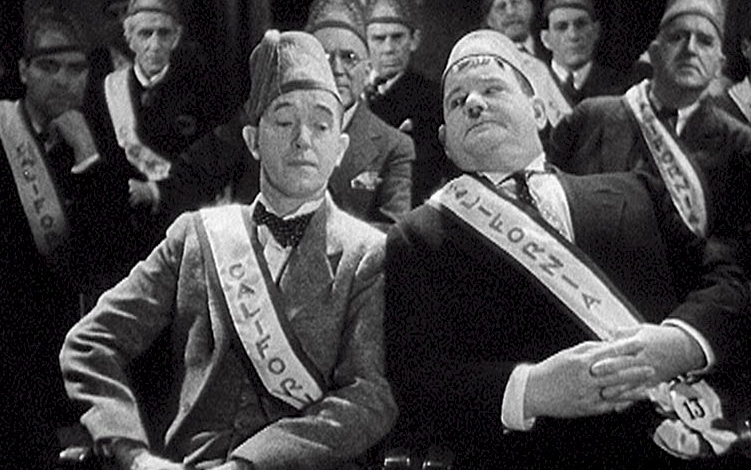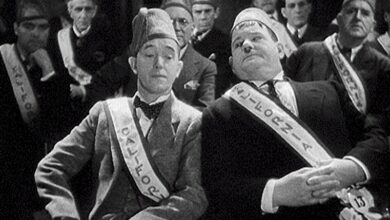A little light opera. A little gallows humour. Laurel and Hardy in “The Devil’s Brother” aka “Fra Diavolo” (1933).

When certain people try to praise Laurel and Hardy, they for some reason stress the “innocence” of their comedy. Well, the characters of Stan and Ollie are certainly innocent in some respects, though the world around them is never innocent. Furthermore, there’s an authentic darkness to many of their films that twenty-first century mainstream comedy rarely ventures into. Most twenty-first century movie comedies feature a redemptive happy ending. Most Laurel and Hardy films do not. Most twenty-first century movie comedies assume a world in which well-intentioned idiocy will eventually be rewarded within by the moral economy of a benign and indulgent cosmos. Most Laurel and Hardy movies do not.
The Devil’s Brother (1933), meanwhile showcases the second most disturbing scene in the whole Laurel and Hardy oeuvre (wait for The Flying Deuces for the most disturbing). Stan (Stanlio) is ordered at gunpoint (or musketpoint) to hang Ollie (Ollio) or face the noose himself. The scene remains funny, not least as a physics problem of strength to weigh ratios. But the pair of them are understandably in tears.
Stanlio: You know, this is gonna hurt you more than it does me. Put yourself in my place.
Ollio: I wish I could.
Hanging would remain an inexact science until the late nineteenth-century so Stan’s inability to hang Ollie in the early eighteenth-century is wholly understandable.
For this is an incursion into light opera (Daniel Auber, 1830), into the same world of central European valleys and villagers and sudden arias we revisit in The Bohemian Girl and Swiss Miss. The titular Devil’s Brother is played by Dennis King – a dashing but very ruthless Italian bandit who swans about in high society in the guise of the Marquis de San Marco. Our old friends James Finlayson and Thelma Todd are also in the cast as an ill-matched aristocratic couple. Finlayson is understandably if hilariously jealous and protective regarding his very young wife, who at one point is seen drooling over herself in the mirror wearing elaborate eighteenth-century underwear trilling an aria the gist of which is “I’d do me.” Diavolo himself is known by the repeated aria “On Yonder Rock Reclining…” -which sends villagers flying for cover as soon as they hear it.
Diavolo has two weaknesses – an inordinate if understandable fondness for his own singing voice – which does tend to give the game away – and a bizarre decision to make Stanlio and Ollio his most trusted servants (despite their obvious ineptitude and the fact that they’ve already tried to betray him once).
The Devil’s Brother inaugurates a new kind of Laurel and Hardy film – the kind of story which unfortunately would dominate in the sorry films of the 1940s – where Stan and Ollie offer comic relief supporting more obvious romantic leads. That said, they are still allowed plenty of room this film, and to incorporate some very effective routines.
This film also develops the growing notion (developed further in later films) that Stan is not as other men. He can do things with his body that others cannot. These powers are not yet supernatural, but merely feats of dexterity. “Kneesy-Earsy-Nosey” and “Finger Wiggle” infuriate Ollie and enrage the local innkeeper.
Stan spends much of the end of the film drunk – simply because he has no other means of disposing of surplus wine once a pitcher is full.
And then Stanlio and Ollio laugh. Stanlio laughs because he is drunk and Ollie laughs because Stanlio’s laugh is infectious. And we laugh because they laugh – and for no other explicable reason at all.
As it happens, laughing uproariously at nothing in particular is a staggeringly difficult acting challenge.
Try it at home. Just try it. You’ll give up and start playing “Kneesy-Earsy-Nosey” instead.





